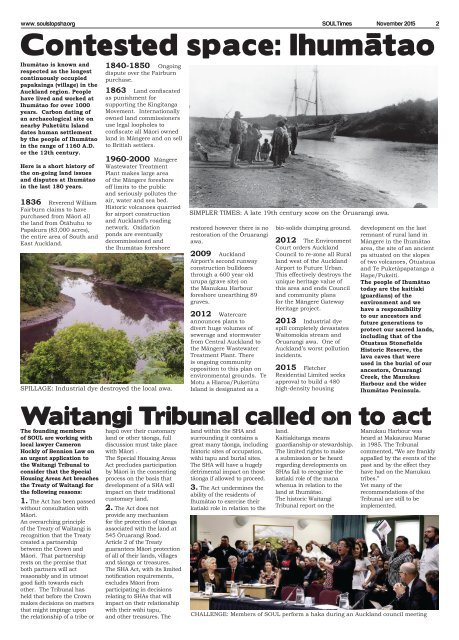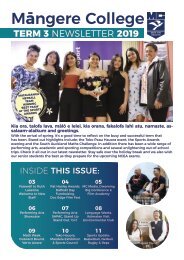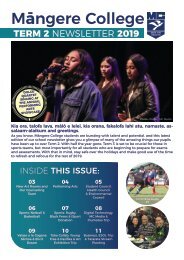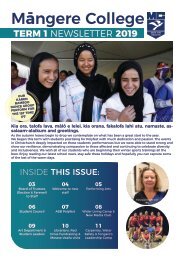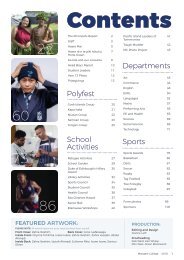SOUL TIMES ONLINE
You also want an ePaper? Increase the reach of your titles
YUMPU automatically turns print PDFs into web optimized ePapers that Google loves.
www. soulstopsha.org <strong>SOUL</strong>Times November 2015 2<br />
Contested space: Ihumätao<br />
Ihumātao is known and<br />
respected as the longest<br />
continuously occupied<br />
papakainga (village) in the<br />
Auckland region. People<br />
have lived and worked at<br />
Ihumātao for over 1000<br />
years. Carbon dating of<br />
an archaeological site on<br />
nearby Puketūtu Island<br />
dates human settlement<br />
by the people of Ihumātao<br />
in the range of 1160 A.D.<br />
or the 12th century.<br />
Here is a short history of<br />
the on-going land issues<br />
and disputes at Ihumātao<br />
in the last 180 years.<br />
1836 Reverend William<br />
Fairburn claims to have<br />
purchased from Māori all<br />
the land from Ōtāhuhu to<br />
Papakura (83,000 acres),<br />
the entire area of South and<br />
East Auckland.<br />
1840-1850 Ongoing<br />
dispute over the Fairburn<br />
purchase.<br />
1863 Land confiscated<br />
as punishment for<br />
supporting the Kingitanga<br />
Movement. Internationally<br />
owned land commissioners<br />
use legal loopholes to<br />
confiscate all Māori owned<br />
land in Māngere and on sell<br />
to British settlers.<br />
1960-2000 Māngere<br />
Wastewater Treatment<br />
Plant makes large area<br />
of the Māngere foreshore<br />
off limits to the public<br />
and seriously pollutes the<br />
air, water and sea bed.<br />
Historic volcanoes quarried<br />
for airport construction<br />
and Auckland’s roading<br />
network. Oxidation<br />
ponds are eventually<br />
decommissioned and<br />
the Ihumātao foreshore<br />
SPILLAGE: Industrial dye destroyed the local awa.<br />
SIMPLER <strong>TIMES</strong>: A late 19th century scow on the Ōruarangi awa.<br />
restored however there is no<br />
restoration of the Ōruarangi<br />
awa.<br />
2009 Auckland<br />
Airport’s second runway<br />
construction bulldozes<br />
through a 600 year old<br />
urupa (grave site) on<br />
the Manukau Harbour<br />
foreshore unearthing 89<br />
graves.<br />
2012 Watercare<br />
announces plans to<br />
divert huge volumes of<br />
sewerage and stormwater<br />
from Central Auckland to<br />
the Māngere Wastewater<br />
Treatment Plant. There<br />
is ongoing community<br />
opposition to this plan on<br />
environmental grounds. Te<br />
Motu a Hiaroa/Puketūtu<br />
Island is designated as a<br />
bio-solids dumping ground.<br />
2012 The Environment<br />
Court orders Auckland<br />
Council to re-zone all Rural<br />
land west of the Auckland<br />
Airport to Future Urban.<br />
This effectively destroys the<br />
unique heritage value of<br />
this area and ends Council<br />
and community plans<br />
for the Māngere Gateway<br />
Heritage project.<br />
2013 Industrial dye<br />
spill completely devastates<br />
Waitomokia stream and<br />
Ōruarangi awa. One of<br />
Auckland’s worst pollution<br />
incidents.<br />
2015 Fletcher<br />
Residential Limited seeks<br />
approval to build a 480<br />
high-density housing<br />
development on the last<br />
remnant of rural land in<br />
Māngere in the Ihumātao<br />
area, the site of an ancient<br />
pa situated on the slopes<br />
of two volcanoes, Ōtuataua<br />
and Te Puketāpapatanga a<br />
Hape/Pukeiti.<br />
The people of Ihumātao<br />
today are the kaitiaki<br />
(guardians) of the<br />
environment and we<br />
have a responsibility<br />
to our ancestors and<br />
future generations to<br />
protect our sacred lands,<br />
including that of the<br />
Ōtuataua Stonefields<br />
Historic Reserve, the<br />
lava caves that were<br />
used in the burial of our<br />
ancestors, Ōruarangi<br />
Creek, the Manukau<br />
Harbour and the wider<br />
Ihumātao Peninsula.<br />
Waitangi Tribunal called on to act<br />
The founding members<br />
of <strong>SOUL</strong> are working with<br />
local lawyer Cameron<br />
Hockly of Bennion Law on<br />
an urgent application to<br />
the Waitangi Tribunal to<br />
consider that the Special<br />
Housing Areas Act breaches<br />
hapū over their customary<br />
land or other tāonga, full<br />
discussion must take place<br />
with Māori .<br />
The Special Housing Areas<br />
Act precludes participation<br />
by Māori in the consenting<br />
process on the basis that<br />
land within the SHA and<br />
surrounding it contains a<br />
great many tāonga, including<br />
historic sites of occupation,<br />
wāhi tapu and burial sites.<br />
The SHA will have a hugely<br />
detrimental impact on those<br />
tāonga if allowed to proceed.<br />
land.<br />
Kaitiakitanga means<br />
guardianship or stewardship.<br />
The limited rights to make<br />
a submission or be heard<br />
regarding developments on<br />
SHAs fail to recognise the<br />
katiaki role of the mana<br />
Manukau Harbour was<br />
heard at Makaurau Marae<br />
in 1985. The Tribunal<br />
commented, “We are frankly<br />
appalled by the events of the<br />
past and by the effect they<br />
have had on the Manukau<br />
tribes.”<br />
the Treaty of Waitangi for development of a SHA will<br />
3. The Act undermines the<br />
whenua in relation to the Yet many of the<br />
the following reasons: impact on their traditional<br />
ability of the residents of<br />
land at Ihumātao.<br />
recommendations of the<br />
1. The Act has been passed<br />
customary land.<br />
Ihumātao to exercise their<br />
The historic Waitangi<br />
Tribunal are still to be<br />
without consultation with 2. The Act does not<br />
katiaki role in relation to the<br />
Tribunal report on the implemented.<br />
Māori.<br />
An overarching principle<br />
of the Treaty of Waitangi is<br />
recognition that the Treaty<br />
created a partnership<br />
between the Crown and<br />
Māori. That partnership<br />
rests on the premise that<br />
both partners will act<br />
reasonably and in utmost<br />
good faith towards each<br />
other. The Tribunal has<br />
held that before the Crown<br />
makes decisions on matters<br />
provide any mechanism<br />
for the protection of tāonga<br />
associated with the land at<br />
545 Ōruarangi Road.<br />
Article 2 of the Treaty<br />
guarantees Māori protection<br />
of all of their lands, villages<br />
and tāonga or treasures.<br />
The SHA Act, with its limited<br />
notification requirements,<br />
excludes Māori from<br />
participating in decisions<br />
relating to SHAs that will<br />
impact on their relationship<br />
that might impinge upon with their wāhi tapu,<br />
the relationship of a tribe or and other treasures. The<br />
CHALLENGE: Members of <strong>SOUL</strong> perform a haka during an Auckland council meeting


